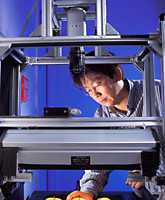High-Tech Approach Uses Lights, Action, And Camera To Scrutinize Fresh Produce

High-tech tactics to carefully examine apples and other fresh produce items as they travel along packinghouse conveyor belts can help ensure the quality and safety of foods. USDA scientists in Beltsville, MD, have developed and patented an experimental, cutting-edge optical scanning system that would use two different kinds of lighting, a sophisticated camera, and other pieces of equipment to scrutinize produce while it’s still at the packinghouse.

ARS biophysicist Moon Kim
and colleagues have developed
and patented a multispectral optical
scanning system that can find some
defects and contaminants on fresh
produce at the packinghouse.
Photo: USDA-ARS
The system would provide, in a single image, evidence of certain kinds of defects or contaminants, according to USDA Agricultural Research Service (ARS) biophysicist Moon S. Kim. Defects could include cuts and bruises. Contaminants might include specks of fertilizer from orchard or field soil.
Kim, ARS agricultural engineers Yud-Ren Chen (now retired) and Kuanglin (Kevin) Chao, and ARS biomedical engineer Alan M. Lefcourt received a patent in 2010 for their automated approach to detecting defects and contaminants on the exterior of fresh produce and other items.
The team’s system harnesses the capabilities of a type of camera known as a high-speed multispectral/hyperspectral line-scanner. Positioned above a conveyor belt, the scanner captures images of each fast-moving item, such as an apple. Each apple is exposed simultaneously to ultra-violet light from a UV fluorescent lamp and near infrared light from a halogen lamp. The near infrared light that bounces off the apple can be captured by an instrument known as a spectrograph and analyzed for tell-tale patterns of defects, while the UV light beamed on the apple can disclose the whereabouts of contaminants.
The system combines information from both forms of illumination into a single image with contaminant and defect results. When linked to a sorting machine, the system can signal the sorter to separate the problem apples from others.
At present, the system offers, at the rate of about three to four apples per second, a 180-degree view of each apple’s exterior, Kim reports. The scientist are working to improve the process so it will provide a 360-degree whole-surface view for thorough inspection.
For the full article, click here.
Source: USDA-ARS








